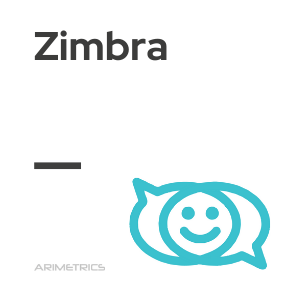
Definición:
Zimbra is a collaborative computer program that is composed of emails, calendars, contacts, documents, etc. That is, it is a web-based application package that can be deployed as an on-premises private cloud or off-premises cloud storage. It is designed for enterprise deployment with the primary goal of integrating a host of collaboration tools.
Zimbra Server supports desktop email clients, such as Windows Outlook, and demonstrates compatibility with Windows, Linux and Apple computer systems. In addition, it provides wireless synchronization with mobile device operating systems such as iOS, Windows Mobile, BlackBerry, and Android.
Zimbra Features
Zimbra offers a wide range of functionalities that facilitate collaboration and communication within organizations, adapting to the current technological needs.
- Email and calendaring: Zimbra offers a robust email system with integrated calendars, allowing users to manage their communications and schedules efficiently.
- Mobile synchronization: Provides wireless synchronization with mobile devices using iOS, Windows Mobile, BlackBerry and Android, facilitating access to e-mails and calendars from anywhere.
- Cross-platform compatibility: It is compatible with Windows, Linux and Apple operating systems, as well as desktop email clients such as Windows Outlook.
- Ajax-based administration interface: Thanks to the combination of JavaScript with XML, Zimbra allows real-time updates without the need to reload the page, offering a fluid and interactive user experience.
- Command interface: Includes a console for command entry, allowing users to execute direct instructions to the program.
- API for integration: Provides an API that facilitates bi-directional integration with CRM systems, ERP and other enterprise applications.
- Scalability: Designed to increase work capacity without affecting performance, making it ideal for growing companies.
- Security: Its open source nature allows for continuous code reviews, ensuring a high level of security and transparency.
Zimbra: history and evolution
Zimbra was first launched in 2005 as an enterprise collaboration solution that integrated multiple tools into a single package. Its innovative approach to integrating email, calendaring and other collaborative applications quickly positioned it as an attractive alternative to traditional email management solutions. Its acquisition by Yahoo! in 2007 and subsequently by VMware in 2010, and then by Telligent Systems, reflect its growth and adaptation to the changing needs of the enterprise market. Over the years, Zimbra has evolved to offer greater support for mobile platforms and better integration with other enterprise applications.
Evolution of Zimbra:
- 2005: Initial launch of Zimbra, featuring an advanced web interface.
- 2007: Acquisition by Yahoo!, which boosted its visibility and development.
- 2010: Acquisition by VMware, which integrated Zimbra into its enterprise solutions portfolio.
- 2013: Acquisition by Telligent Systems, with a renewed focus on social collaboration.
- Actuality: Continuous development and improvements in the integration with mobile systems and third party applications.
Advantages of Zimbra
Zimbra has been a real success, the integration of several applications in the same tracker has managed to attract millions of users around the world. Among the main advantages of Zimbra we find the following
- Savings: compared to other similar programs such as Roundcube or MS Exchange, Zimbra’s management costs represent significant savings, in some cases more than 50%.
- OpenSource Platform:The open source version of Zimbra allows the different developers of the community to contribute to improving the program in succession, thus multiplying its possibilities.
- Accessibility:Being a service hosted by cloud computing, it allows the user access from anywhere they have an Internet connection.
- Personalization:the multiplés options that the work of the community allows us to customize according to the needs of the user.
- Ajax-based administration interface: thanks to the combination of Javascript with XML, the web can update changes without reloading, thus creating an interactive application.
- Command interface:Includes a console for entering commands and thus giving instructions to the program.
- API for bi-directional integration with CRM, ERP, etc.
- Scalability:zimbra allows us to increase the work capacity without harming its operation, achieving really surprising results.
- Security:thanks to the open source system we can have an extremely transparent program and in this way much more secure, since it allows the code to be reviewed and security controls to be carried out permanently.
Where to download Zimbra?
Zimbra can be downloaded directly and free of charge from the following link:
https://www.zimbra.com/try/zimbra-collaboration-open-source/
